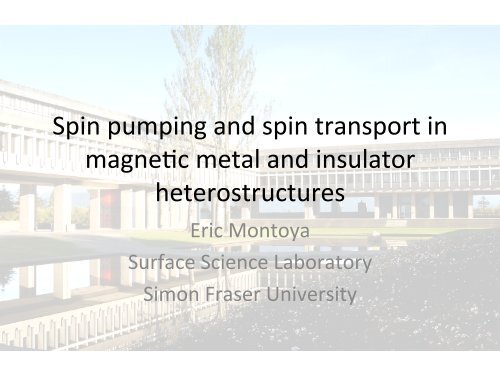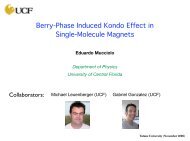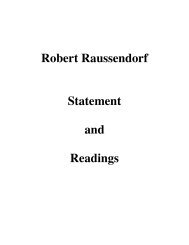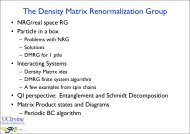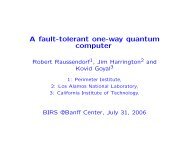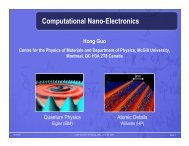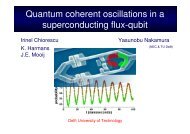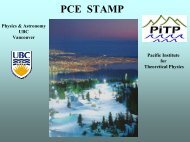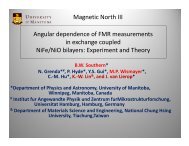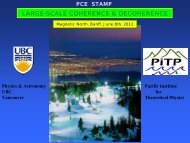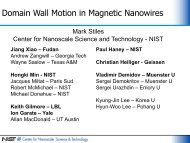Spin pumping and spin transport in magne0c metal and insulator ...
Spin pumping and spin transport in magne0c metal and insulator ...
Spin pumping and spin transport in magne0c metal and insulator ...
You also want an ePaper? Increase the reach of your titles
YUMPU automatically turns print PDFs into web optimized ePapers that Google loves.
<strong>Sp<strong>in</strong></strong> <strong>pump<strong>in</strong>g</strong> <strong>and</strong> <strong>sp<strong>in</strong></strong> <strong>transport</strong> <strong>in</strong> <strong>magne0c</strong> <strong>metal</strong> <strong>and</strong> <strong>in</strong>sulator heterostructures Eric Montoya Surface Science Laboratory Simon Fraser University
Why use <strong>sp<strong>in</strong></strong> currents? We can elim<strong>in</strong>ate circumvent these problems: • Joule Hea0ng • Circuit Capacitance • Electron migra0on Outl<strong>in</strong>e: • Introduce <strong>sp<strong>in</strong></strong> <strong>pump<strong>in</strong>g</strong> • <strong>Sp<strong>in</strong></strong> <strong>transport</strong> <strong>in</strong> Au • <strong>Sp<strong>in</strong></strong> <strong>pump<strong>in</strong>g</strong> from <strong>magne0c</strong> <strong>in</strong>sulator (if 0me) Au Fe Au Fe Au Fe Au YIG Magne0c <strong>metal</strong> Magne0c <strong>in</strong>sulator
Ferromagnetic Resonance(FMR)Anritsu signal generator: 1-70 GHzelectromagnet: 2.8 T∂ M∂t<strong>Sp<strong>in</strong></strong> Dynamics (LLG)L<strong>and</strong>au Lifshitz Gilbert M = −γ × Heff + α M × ∂ n∂tn =MM sBulk damp<strong>in</strong>g is noise <strong>in</strong> <strong>sp<strong>in</strong></strong> orbit (s-o) <strong>in</strong>teractionInterface damp<strong>in</strong>g is <strong>sp<strong>in</strong></strong> <strong>pump<strong>in</strong>g</strong>H eff36GHz !MFMR l<strong>in</strong>ewidth:ωΔH = αγGα =γM s
FM1NM<strong>Sp<strong>in</strong></strong> Pump<strong>in</strong>g FM2I mm NMm = −gµ B Sx0 L<strong>Sp<strong>in</strong></strong> current arises from the 0me retarded response to <strong>in</strong>terlayer exchange coupl<strong>in</strong>g The <strong>sp<strong>in</strong></strong> current can be expressed as an accumulated <strong>magne0c</strong> moment (/area) I m = −gµ BM ∂ˆn∂M Re [g ↑↓ ] × ⊗ ˆx= 1 ∂m4πM s ∂t∂t d FM ∂t<strong>Sp<strong>in</strong></strong> mix<strong>in</strong>g conductance for <strong>metal</strong>s Re [g ↑↓ ]= 1 [|r ↑,n − r ↓,n | 2 + |t ↑,n − t ↓,n | 2 ]2n|r ↑(↓),n | 2 + |t ↑(↓),n | 2 ∗=1 r ↑,n r ↓,n + t ↑,n t ↓,n 0g ↑↓ = n∗∗[1 − Re[r ↑,n r ↓,n + t ↑,n t ↓,n∗≈ k F 24π ∼ N 2/3Density of electrons per <strong>sp<strong>in</strong></strong> direc0on <strong>in</strong> NM
FM1NM<strong>Sp<strong>in</strong></strong> Pump<strong>in</strong>g I mFM2δ sd = v Fτsf τ m3m NM0 LThe accumulated <strong>magne0c</strong> moment then diffuses away from then <strong>in</strong>terface I m = −gµ BM ∂ˆn∂m Re [g ↑↓ ] × ⊗ ˆxNM= D ∂2 m NM4πM s ∂t∂t ∂x 2 − 1 mNMτ sfxD = v F 2 τ m3Boundary FM1/NM FM1/NM/FM2x =0I m − 1 2 v Fm NM = −D ∂ m NM∂xx = L∂m NM∂x=0 −D ∂ m NM∂x= 1 2 v Fm NM
<strong>Sp<strong>in</strong></strong> Pump<strong>in</strong>g Theory 9Α 10 3 s6300 100 200 300 400 500 600dAu ALF b =F(d FM , 4"M S , g , g, # B ) F sd =F(! sf , ! m , d NM , v F )×F b ! sf is only unknown parameter
Sample Growth by MBE • GaAs(001) Template – Atomic H etch<strong>in</strong>g – 650eV Ar + spu^er<strong>in</strong>g (con0nuous rota0on) – 4x6 reconstruc0on RHEED monitored • 16Fe <strong>and</strong> 12Fe have different FMR fields • At 16Fe FMR, 16Fe acts as <strong>sp<strong>in</strong></strong> pump <strong>and</strong> 12Fe acts as <strong>sp<strong>in</strong></strong> s<strong>in</strong>k 12Fe (1.7nm)!16Fe (2.3nm)!GaAs(001)!20Au (4.1nm)!300Au (61.2nm)!or!20Au (4.08nm)!S<strong>in</strong>gle Layers Double Layers
Charge Transport !!295R 88= 2.5R 10295= 6.1• Van der Pauw measurements – 10K-‐300K τ m = σm ene 2• Contribu0on due to bulk phonon <strong>and</strong> <strong>in</strong>terface sca^er<strong>in</strong>g • Us<strong>in</strong>g Mathiassen’s Rule: 1= 1 + 1 τ m τ p τ i• Interface sca^er<strong>in</strong>g contribu0on <strong>in</strong>dependent of temperature
Ferro<strong>magne0c</strong> Resonance • FMR followed Gilbert damp<strong>in</strong>g phenomenology: ∆H(ω) =α ω γ + ∆H(0)• Enhanced Gilbert damp<strong>in</strong>g due to <strong>sp<strong>in</strong></strong> <strong>pump<strong>in</strong>g</strong> is an <strong>in</strong>terface effect • <strong>Sp<strong>in</strong></strong> momentum accumulates at the Fe/Au <strong>in</strong>terface
H Oe15010050Gilbert Damp<strong>in</strong>g 00 10 20 30 40f GHz• $ sp greatest <strong>in</strong> ballis0c limit for double layer • $ sp <strong>in</strong>creases with decreas<strong>in</strong>g temperature for double layers • $ sp decreases with decreas<strong>in</strong>g temperature for s<strong>in</strong>gle layers Α 10 3 963300Au SL 300Au DL 20Au SL 20Au DL 0100 150 200 250 300Temperature K
Relaxa0on parameters Τ 10 13 s2.52.01.51.0τ sf (90K)τ p (90K) = 22.1τ sf (290K)τ p (290K) =8.4• ! sf <strong>in</strong>creases faster than ! p as temperature decreases • ! i very weakly dependent on temperature 0.50.00 50 100 150 200 250Temperature K<strong>Sp<strong>in</strong></strong> flip sca^er<strong>in</strong>g dom<strong>in</strong>ated by phonon processes Comb<strong>in</strong>ed <strong>in</strong>fluence of temperature dependent <strong>sp<strong>in</strong></strong> flip sca^er<strong>in</strong>g at <strong>in</strong>terfaces <strong>and</strong> bulk phonon sca^er<strong>in</strong>g? or Mul0-‐phonon sca^er<strong>in</strong>g that does not contribute strongly to resis0vity?
ONCHESKY et al.the boundary condi-Previous Studies J. Appl. Phys. 103, 07C509PHYSICAL REVIEW B 71, 214440 5magnetic moment con-6T. Monchesky et. al. Phys.Rev.B. 71 (2005) B. Kardasz et. al. J.Appl.Phys. 103 (2008) FIG. 6. In situ measurement of the conductivity FIG. as 1. aDependence function of of the additional damp<strong>in</strong>g by <strong>sp<strong>in</strong></strong> <strong>pump<strong>in</strong>g</strong>, sp ,u thickness deposited on 28 ML Fe/GaAs001. The two curvesreF1/NM/F2 calculated us<strong>in</strong>g first-pr<strong>in</strong>ciples the From bound-parameters are equivalent described by l<strong>in</strong>e to AEq.! 80-‐5nm density functional thickness Au cap layercalculations. of thickness Au ! d Au the Au/16Fe/GaAs001 samples. Ti <strong>in</strong>creases by a factor of 12 he solid l<strong>in</strong>e P=0, S ↑ =0.55, S ↓ =0.77 is the best fit given the setfe <strong>in</strong> Fig. 7 below. sf only <strong>in</strong>creases by a factor of 1.5 The dashed l<strong>in</strong>eP=0.41,M/F2S ↑ =0.03,<strong>in</strong>terfaceS ↓ =0.65arehas 5 wave frequency f, Hf. Hf followed well a l<strong>in</strong>ear dependencethe highest The 2 among error thebars paramterson l<strong>in</strong>e A, which demonstrates the sensitivity of the fit to thewere determ<strong>in</strong>ed FIG. 7. Fitt<strong>in</strong>g fromofsmall the conductivity slope variations of 20 ML <strong>in</strong> Au/1 theFe/7 ML Au/28 ML Fe/GaAs001 us<strong>in</strong>g first-pr<strong>in</strong>ciples catt<strong>in</strong>g parameters. ! measurements. The solid l<strong>in</strong>e shows fitt<strong>in</strong>g us<strong>in</strong>g the <strong>sp<strong>in</strong></strong> <strong>pump<strong>in</strong>g</strong>sf can only weakly be dependent on <strong>in</strong>terface sca^er<strong>in</strong>g with the follow<strong>in</strong>g parameters.: tions. The filled po<strong>in</strong>ts correspond to the parameters which givg˜↑↓ =2.410 15 cm −2 , el =1.210 −147correct sheet resistance for a parallel configuration of magnetihree fitt<strong>in</strong>g parameters rema<strong>in</strong>ed: S ↑ ,S ↓ , <strong>and</strong> sf =1510P vac/Au . Unforunatelya unique fit to the data was not achieved with the the correct sheet resistance for an antiparallel zero applied−14 s.ments resistance at saturation <strong>in</strong> Fig. 2 <strong>and</strong> the open po<strong>in</strong>tsata <strong>in</strong> Fig. Temperature 6 alone. dependence of ! configuration. The triangles, diamonds, <strong>and</strong> squares are calcuare The valid magnetoresistance for the case data fromparameters: sf governedAu/Fe/Au/Fe/ <strong>in</strong>tr by mul?-‐phononfor =3.510 P vac/Au =0, 0.25, −3 scaAer<strong>in</strong>g, <strong>and</strong> g˜↑↓ 0.5, =2.410 respectively. The 15 cm dashed −2 l<strong>in</strong>es , el laaAs001 was used to help determ<strong>in</strong>e the specularity −14 pa- A <strong>and</strong> B −14 are <strong>in</strong>terpolations of the po<strong>in</strong>ts of <strong>in</strong>tersection whichsymbols represent the measured data from the H dependence on m
!<strong>Sp<strong>in</strong></strong> <strong>pump<strong>in</strong>g</strong> at YIG/Au <strong>in</strong>terfacerecently new ideas <strong>and</strong> systems be<strong>in</strong>g developed for generationof pure <strong>sp<strong>in</strong></strong> currents for driv<strong>in</strong>g <strong>Sp<strong>in</strong></strong> Transfer Torque (STT) devicesJohn Slonczewski has shown higher <strong>sp<strong>in</strong></strong> efficiency can be achieved by thermal gradientsus<strong>in</strong>g Magnetic Insulator (MI)/NM heterostructuresJ. Slonczewski, PRB 82, 054403 (2010)new emerg<strong>in</strong>g field<strong>sp<strong>in</strong></strong>coloritronicsArne Brataas <strong>and</strong> Gerrit Bauer have shown that the <strong>sp<strong>in</strong></strong> <strong>pump<strong>in</strong>g</strong> generationis determ<strong>in</strong>ed at MI/NM <strong>in</strong>terfaces by <strong>sp<strong>in</strong></strong> mix<strong>in</strong>g conductanceg "#?????what is at the YIG/Au <strong>in</strong>terface ????
<strong>Sp<strong>in</strong></strong> mix<strong>in</strong>g conductance <strong>in</strong> <strong>magne0c</strong> <strong>in</strong>sulators g "# = 1 2( | r "n$ r n#| 2 + | t n"$ t n#| 2)%n!t n"#= 0r n"#=1$ e i% n "#!$n( )g !" ! = 1# cos(! ! n#! " n)B. He<strong>in</strong>rich et al. PRL, 107, 066604 (2011)C. Burrowes et al. APL , 100, 092403 (2012)
YIG surface chemistry YIG: Y 3 Fe 2 (FeO 4 ) 3 • Grown on (111) Gd 3 Ga 5 O 12 substrate by PLD at 700C <strong>and</strong> 0.1Torr O 2 • Thickness d=9nm (low angle XRD) • 4"Ms=1.31kG(SQUID), g=2.027 (FMR) • Surface roughness 0.5nm (AFM) FeOCXPSYAs prepared YIG has surface deficiency of Fe Common for even thick PLD prepared YIG
<strong>Sp<strong>in</strong></strong> <strong>pump<strong>in</strong>g</strong> from YIG 9nmYIGa9nm YIG/6.1nm Au/4.3nm Fe/6.1nm AubAmplitude a.u.∆H = 15.9OeAmplitude a.u.∆H = 21.2OeTransfer of angular momentum to Fe layer is seen as loss of angular momentum <strong>in</strong> YIG layer 7.3 7.6 7.9H kOe7.3 7.6 7.9H kOe60Damp<strong>in</strong>g! 50g !"#1.3$10 14 cm %212% efficiency compared to Fe H Oe4030201000 10 20 30 40frequency GHz
Evalua0ng g !"<strong>in</strong> Ar+ etched YIG H Oe120100806040200Low angle Ar+ etched10m<strong>in</strong>utes0.8kV, 400 o C0 10 20 30 40f GHz9YIG(etched)/6.1Au/4.3Fe/6.1Au ! = 0.00699YIG(etched)/6.1Au! = 0.0014g !"= 5.1#10 14 cm $270% of predictedby first pr<strong>in</strong>ciples calculationsX. Jia et al. Europhysics Letters 96, 17005 (2011)50% of Fe/Au
XPS on YIG678&./ 01. &2(&6:8&./ 01. &2(&698&34&5&&6$8&34&5&Prolonged etch<strong>in</strong>g lead to <strong>metal</strong>lic Fe -‐> Suppresses <strong>pump<strong>in</strong>g</strong> !"#$"#%&'#()%*&+(,-&required change for <strong>in</strong>creasedg !"725 720 715 710 705 700E b [eV]<strong>metal</strong>lic state of Fedecreases rapidlyg !"# 3.7$10 14 cm %2
<strong>sp<strong>in</strong></strong> pump/s<strong>in</strong>k effectcan be used to<strong>in</strong>vestigate the <strong>sp<strong>in</strong></strong> <strong>transport</strong> parameters <strong>in</strong> magnetic nanostructuresConclusions:<strong>sp<strong>in</strong></strong> <strong>pump<strong>in</strong>g</strong> at YIG/Au is efficient70% of theory calc. 50% of Fe/Auevidence that a time retarded <strong>in</strong>terlayer exchange coupl<strong>in</strong>gcreates <strong>sp<strong>in</strong></strong> <strong>pump<strong>in</strong>g</strong>!4! "g !"s<strong>in</strong> 2 #$!4! g !"! 2k T mB YIG&%V cohM sEfficiency of <strong>sp<strong>in</strong></strong> <strong>pump<strong>in</strong>g</strong> comparison( #T Au )J. Xiao et al. PRB 81, 214418 (2010)Microwave driven: for f=10GHz <strong>and</strong> Θ=90 o 2x10 10Thermal excitation: for ΔT=10 K , V coh =2.7x10 3 nm 3 ω eff =2x10 2 MHz 1.0x10 8STT (60% polarization): for 2x10 6 Acm -2 : 2x10 10')(( !T Au )"! eff= " 2k BT mYIG$#V cohM s!%'&nm -2
Simon Fraser UniversityPhysics, MagnetismDr. Bret He<strong>in</strong>rich Prof. Emeritus Eric MontoyaPhD C<strong>and</strong>idateDr. Bartek Kardaszresearch associateDr. Capuc<strong>in</strong>e BurrowesPDFDr. Erol GirtProfessorCharles EyrichMSc C<strong>and</strong>idateDr. Monika AuroraPhD C<strong>and</strong>idateDr. Wendell HuttemaPDFartist: Mr. Clarence MillsKen MyrtleResearch AssistantProf. M<strong>in</strong>gzhong Wu, Dr.Young-Yeal Song, <strong>and</strong> Dr. Yiyan SunPhysics DepartmentColorado State UniversityFort Coll<strong>in</strong>s, USAAcknowledgements:NSERC, CIfAR , NSF, NIST
Conclusions Temperature dependence of ! sf Thickness dependence of ! sf from 290K to 90K ! sf <strong>in</strong>creases by factor of 10 ! p <strong>in</strong>creases by factor of 4 ! i negligible dependence from 80nm to 5nm ! sf <strong>in</strong>creases by factor of 1.5 ! p constant ! i <strong>in</strong>creases by factor of 12 Temperature dependence of ! sf governed by mul0-‐phonon sca^er<strong>in</strong>g
deposition of Fe on bare YIGresults <strong>in</strong> <strong>metal</strong>lic state of Fe1 MLFe depositedat 500 o Cno <strong>sp<strong>in</strong></strong> <strong>pump<strong>in</strong>g</strong>704 708 712 716B<strong>in</strong>d<strong>in</strong>g Energy [eV]<strong>metal</strong>lic state of FeYIG state of FeYIG surface H atom etch<strong>in</strong>g showed <strong>in</strong> XPSa strong presenceof <strong>metal</strong>lic state of Feno <strong>sp<strong>in</strong></strong> <strong>pump<strong>in</strong>g</strong>704 708 712 716 720B<strong>in</strong>d<strong>in</strong>g Energy [eV]<strong>sp<strong>in</strong></strong> current blockade by <strong>metal</strong>lic Fe


